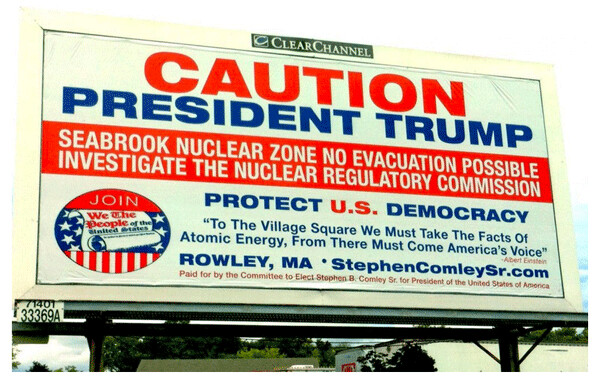News & Articles
Browse all content by date.

Ever wonder if the nuclear reactor near you has an evacuation plan that would work in an emergency? Have you ever been stuck in barely moving traffic on an interstate highway when there was absolutely no crisis?
People driving near the Seabrook reactor in New Hampshire have. And they have reason to worry too, especially after the nonprofit group We the People (WTP) and its founder Stephen Comley, Sr. sponsored a billboard in the town of Salisbury, and produced a widely seen public service video* of traffic jams on Interstate 95, the escape route, warning, “CAUTION: No Evacuation Possible.”
We the People’s public warnings have been so effective that major state politicians and town councils within the 10-mile “Emergency Planning Zone” or evacuation area, are raising their own alarms.
Massachusetts State Senate Minority Leader Bruce Tarr and State Representative Brad Hill wrote Oct. 10, 2018, to Mass. Attorney General Maura Healey, complaining of “constituent inquiries” about Seabrook’s evacuation plans. The lawmakers wrote that the public “has become increasingly concerned about effectively evacuating the area in the event [of] a nuclear emergency,” noting that the “drone-recorded video of the Hampton Beach during the summer tourist season … shows the heavy traffic congestion on the seacoast.”
Comley and We the People have also succeeded in winning town council resolutions from half a dozen local municipalities in Massachusetts and New Hampshire, that call on state and federal agencies to convene a public hearing where emergency first responders could explain the evacuation plans.
Last September 25, New Hampshire State Representative Peter Schmidt wrote to AG Healey about the “urgency” of having first responders “testify as to the plans and possibilities for safely, effectively and expeditiously evacuating the seacoast in the event of a nuclear emergency.” Several New Hampshire and Massachusetts towns within the evacuation zone have “strongly endorsed We the People’s call for this first responder hearing,” Schmidt wrote.
Rep. Schmidt’s letter raised two additional issues that Mr. Comley and WTP have brought to light. What Schmidt called “some sort of gag order” has allegedly been imposed on the Massachusetts State Police and the New Hampshire National Guard, forbidding them from speaking about evacuation issues.
Mr. Comley made a formal, recorded presentation to the Mass. State Police on Sept. 2, 2016, regarding the question of the gag order. Then, the record of the proceedings was lost, according to Trooper Christina Lucin of the state patrol’s Fraud Identification Unit. Rep. Schmidt complained to AG Healey that “[T]he disappearance of the record is very troubling.”
Seabrook is 13 miles south of Portsmouth, New Hampshire, and 40 miles north of Boston. These cities are outside the 10-mile evacuation zone, but in March 2011, the US Nuclear Regulatory Commission (NRC) recommended evacuation of US residents within 50 miles of Japan’s Fukushima meltdowns.
The Seabrook reactor is set between Seabrook and Hampton Falls, New Hampshire, only 1.2 miles east of Interstate 95; Hampton Beach and its popular state park are just 1.6 miles to the east.
In January 2018, the town of Merrimac, Massachusetts (8.6 miles from the reactor) joined six other communities inside the evacuation zone “calling for the NRC to hold a hearing on whether the Seabrook, NH nuclear power plant’s evacuation plan can be effectively implemented.”
Healey’s office has still not agreed to schedule a public hearing for first responders.
| Tweet |

